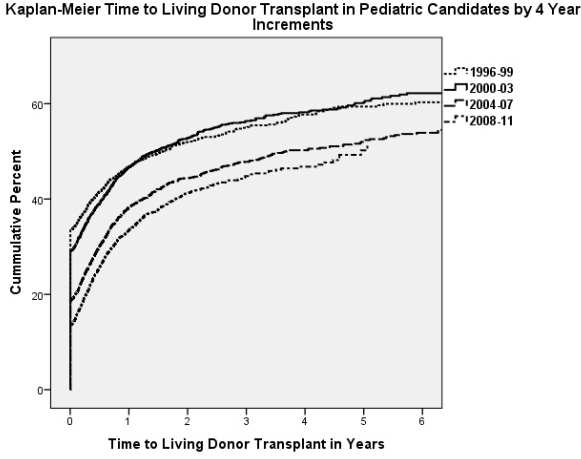Living Donor Transplant Rates in Children Are Declining
University of Virginia, Charlottesville, VA.
Meeting: 2015 American Transplant Congress
Abstract number: D223
Keywords: Donation, Kidney transplantation, Pediatric
Session Information
Session Name: Poster Session D: Pediatric Clinical Kidney Transplantation
Session Type: Poster Session
Date: Tuesday, May 5, 2015
Session Time: 5:30pm-6:30pm
 Presentation Time: 5:30pm-6:30pm
Presentation Time: 5:30pm-6:30pm
Location: Exhibit Hall E
Living donor (LD) transplant rates have been declining since 2004 in adult candidates. We sought to determine if this trend is also occurring in pediatric kidney transplant candidates and to explore if the Share 35 program implemented in 2005 has affected LD rates in children.
To test these hypotheses we selected all children listed for a kidney transplant or transplanted with a LD without listing in the SRTR database between 1996 and 2011. A total of 14,911 potential recipients were identified. Racial and ethnic distribution of pediatric candidates has changed over time. Caucasian candidates decreased from 57.2% to 46.6% associated with an increase in the proportion of Hispanic candidates from 16.1% to 27.9%. The proportion of AA candidates remained stable. Age, gender, prior kidney transplant, and insurance status at listing remained relatively unchanged over the study period. The proportion of children listed initially inactive has increased dramatically from 0.9% to 41.8%. Kaplan-Meier analysis showed a progressive decline in LD rates after 2001. To account for the changes in the population considered for kidney transplant, Cox regression analysis was performed including covariates for age, gender, race/ethnicity, insurance status, status at listing (inactive vs. active), and prior transplant. Figure 2 shows the unadjusted and adjusted hazard ratios for a 16 year period in two year increments and shows the decline in LD transplant among children began after 2001. The unadjusted change in LD transplantation was more dramatic and was mitigated partially by adjustment for the changing demographics and listing practices in pediatric candidates indicating that part of the drop was related to those factors.
To account for the changes in the population considered for kidney transplant, Cox regression analysis was performed including covariates for age, gender, race/ethnicity, insurance status, status at listing (inactive vs. active), and prior transplant. Figure 2 shows the unadjusted and adjusted hazard ratios for a 16 year period in two year increments and shows the decline in LD transplant among children began after 2001. The unadjusted change in LD transplantation was more dramatic and was mitigated partially by adjustment for the changing demographics and listing practices in pediatric candidates indicating that part of the drop was related to those factors.  This downward trend predates implementation of Share 35 but did continue after this change in allocation policy. More aggressive efforts to find living donors for pediatric candidates should be initiated.
This downward trend predates implementation of Share 35 but did continue after this change in allocation policy. More aggressive efforts to find living donors for pediatric candidates should be initiated.
To cite this abstract in AMA style:
Keith D, Lucar ANishio, Vranic G. Living Donor Transplant Rates in Children Are Declining [abstract]. Am J Transplant. 2015; 15 (suppl 3). https://atcmeetingabstracts.com/abstract/living-donor-transplant-rates-in-children-are-declining/. Accessed December 17, 2025.« Back to 2015 American Transplant Congress
